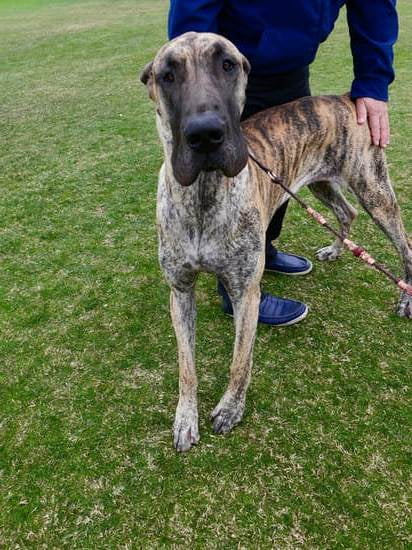Pitbulls are often misunderstood and misrepresented dogs, but with the right training and guidance, they can make excellent therapy dogs. In this article, we will delve into the process of how to train a pitbull to be a therapy dog. Therapy dogs play a crucial role in providing comfort, support, and companionship to individuals in need, such as patients in hospitals or residents in nursing homes.
The bond between a therapy dog and their human counterpart is a special one that can bring immense joy and healing to those they interact with. When properly trained, pitbulls can excel in this role due to their loyal, affectionate nature and eagerness to please. It is essential to understand the responsibilities that come with owning a therapy dog and the impact they can have on the lives of others.
Choosing the right pitbull for therapy training is crucial to ensure success. Not all pitbulls may be suitable for this type of work, so assessing their temperament, trainability, and socialization skills is key. Building a strong bond with your pitbull through positive reinforcement techniques will lay the foundation for successful therapy work. By understanding the unique needs of pitbulls and tailoring your training methods accordingly, you can unlock their full potential as therapy dogs.
The Benefits of Having a Pitbull as a Therapy Dog
One of the key benefits of choosing a Pitbull as a therapy dog is their natural empathy and intuition. Pitbulls have a unique ability to sense emotions and respond accordingly, often offering comfort in times of distress or sadness.
This innate sensitivity allows them to connect on a deep level with individuals who may be struggling with mental health issues, trauma, or loneliness. Additionally, their gentle demeanor and non-judgmental attitude create a safe space for individuals to open up and express themselves freely.
Training a Pitbull to be a therapy dog not only benefits those receiving the comfort and support but also provides numerous advantages for the dog itself. Engaging in therapy work helps fulfill their need for mental stimulation, physical activity, and social interaction.
It also builds their confidence, enhances their obedience skills, and strengthens the bond between the dog and its handler. Ultimately, by training a Pitbull to be a therapy dog, you are not only improving the lives of others but also enriching the life of your furry companion.
Choosing the Right Pitbull for Therapy Training
When it comes to choosing the right pitbull for therapy training, there are several key factors to consider. It is important to remember that not all pitbulls will be suited for this type of work, so selecting the right candidate is crucial for success.
First and foremost, temperament is a primary consideration when choosing a pitbull for therapy training. Look for a pitbull that displays calm, gentle, and friendly behavior towards people and other animals. A good therapy dog should be comfortable in various social settings and able to remain relaxed in potentially stressful situations.
Secondly, consider the age and health of the pitbull. While any age can potentially make a great therapy dog, younger pitbulls may have more energy and require additional training to channel their enthusiasm appropriately. Additionally, ensuring that your pitbull is in good health is essential for them to handle the physical demands of being a therapy dog.
Lastly, evaluate the obedience level of the pitbull before beginning therapy training. Basic obedience skills such as sit, stay, come, and walk on a leash are important foundational skills that will make advanced training much easier. If your pitbull already possesses these basic commands, they may be better equipped to handle the rigors of therapy work.
In summary:
- Consider temperament including calmness and friendliness
- Evaluate age and health for physical demands
- Assess obedience level for easier advanced training
By carefully selecting the right pitbull candidate with all these factors in mind, you will be setting both yourself and your furry companion up for success as you embark on this rewarding journey of training a pitbull to be a therapy dog.
Building a Strong Bond With Your Pitbull
Consistency is another important element in strengthening the bond with your Pitbull. Dogs thrive on routine, so it’s crucial to establish consistent training schedules and rules within the household. This predictability helps your Pitbull feel secure and understand their role in the relationship. Consistency also extends to your interactions with your Pitbull – being reliable in your responses to their behaviors will help reinforce the bond between you.
Communication plays a significant role in building a strong bond with your Pitbull. Understanding your dog’s body language and vocal cues can help you respond appropriately to their needs and emotions. Additionally, positive reinforcement techniques, such as praise and treats, can further enhance communication and reinforce good behavior.
By fostering open communication channels with your Pitbull, you are laying the groundwork for successful therapy training. Taking the time to build a strong bond with your Pitbull will not only benefit their development as a therapy dog but also deepen the connection between you both.
Basic Obedience Training for Therapy Dogs
Basic obedience training is a crucial foundation when preparing a Pitbull to become a therapy dog. Teaching your Pitbull basic commands such as sit, stay, come, and down is essential for their success in therapy work. These commands not only ensure that your Pitbull follows directions in various situations but also helps them demonstrate good behavior during therapy sessions.
Consistency is key when training your Pitbull in basic obedience. Use positive reinforcement techniques such as treats, praise, and playtime to encourage desired behaviors. It’s important to practice these commands regularly in different environments to help your Pitbull generalize their obedience skills. Training sessions should be kept short and enjoyable to maintain your Pitbull’s engagement and focus.
In addition to teaching basic commands, leash manners are also important for a therapy dog. Your Pitbull should be well-behaved on a leash and walk calmly beside you without pulling or lunging. Proper leash etiquette ensures that your Pitbull can safely navigate various environments while maintaining control during therapy visits. Working on loose leash walking and polite greetings with strangers will help prepare your Pitbull for successful interactions during therapy sessions.
| Key Consideration | Detail |
|---|---|
| Training Techniques | Use positive reinforcement like treats and praise |
| Practice Environment | Train in different settings to generalize obedience skills |
| Leash Manners | Foster calm walking behavior and polite greetings with strangers |
Advanced Training Techniques for Therapy Work
When it comes to training a Pitbull to be a therapy dog, advanced training techniques are crucial to ensure that they are well-prepared for the responsibilities that come with this role. One important aspect of advanced training is teaching your Pitbull specific tasks and behaviors that are essential for therapy work. This can include learning how to remain calm in various environments, follow commands reliably, and respond appropriately to different situations they may encounter during therapy sessions.
To start with advanced training, you can incorporate activities that simulate real-life therapy scenarios into your Pitbull’s routine. For example, you can practice walking through crowded areas, interacting with strangers in a controlled setting, or remaining focused amidst distractions. These exercises will help your Pitbull become more comfortable and confident when faced with the unpredictable nature of therapy work.
Additionally, advanced training techniques should focus on strengthening the bond between you and your Pitbull. Building trust and communication is key to successful therapy work, as your Pitbull needs to rely on you for guidance and support in various situations. By continuing to reinforce positive behaviors, providing mental stimulation through interactive games, and maintaining a consistent training schedule, you can ensure that your Pitbull is well-prepared to excel as a therapy dog.
Socializing Your Pitbull for Therapy Settings
Introducing Your Pitbull to New People
One important aspect of socializing your pitbull for therapy settings is introducing them to new people regularly. This can include individuals of different ages, genders, races, and physical appearances. By exposing your pitbull to a diverse group of people, you can help them become more accepting and friendly towards everyone they encounter during their therapy work.
Exposing Your Pitbull to Different Environments
In addition to meeting new people, it’s important to expose your pitbull to various environments. This can include busy streets, parks, shopping centers, schools, hospitals, and nursing homes. By gradually introducing your pitbull to different places and situations, you can help them feel at ease in any setting they may encounter during their therapy visits.
Training Your Pitbull for Positive Interactions
During socialization training for therapy settings, focus on teaching your pitbull how to interact positively with people and other animals. Encourage gentle behavior, calm responses to new stimuli, and the ability to remain focused on their handler even in distracting environments. Positive reinforcement techniques such as treats and praise can help reinforce good behavior and create a positive association with social interactions.
Steps to Officially Certifying Your Pitbull as a Therapy Dog
To officially certify your Pitbull as a therapy dog, there are specific steps and requirements that need to be met. Certification is essential as it ensures that your Pitbull is well-prepared, trained, and suitable for therapy work. Here are some key points to consider when working towards certifying your Pitbull as a therapy dog.
Training Program
One of the first steps in certifying your Pitbull as a therapy dog is enrolling in a training program specifically designed for therapy dogs. These programs typically cover obedience training, socialization skills, basic commands, and how to interact appropriately with different people in varying environments. The training program will help you and your Pitbull understand the expectations and responsibilities of being a therapy team.
Evaluation and Testing
After completing the training program, your Pitbull will need to undergo an evaluation and testing process to assess their readiness for therapy work. This evaluation may include observing your dog’s behavior around strangers, other animals, loud noises, medical equipment, and various stimuli. Your Pitbull should demonstrate good manners, calmness, reliability, and the ability to remain focused during interactions with individuals in need.
Registration With Therapy Dog Organizations
To become officially certified as a therapy dog team, you will need to register with recognized therapy dog organizations such as Therapy Dogs International (TDI) or Pet Partners. These organizations set standards for training, behavior assessment, and liability insurance coverage for therapy dogs. Once registered, you may have to pass additional tests conducted by these organizations to ensure that both you and your Pitbull meet their criteria for certification.
By following these steps diligently – enrolling in a training program, undergoing evaluations/testing processes, and registering with reputable therapy dog organizations – you can successfully certify your beloved Pitbull as a therapy dog. This certification not only validates their capability but also opens up opportunities for them to bring joy and comfort to those in hospitals, nursing homes, schools, or disaster areas.
Maintaining the Health and Well-Being of Your Therapy Pitbull
One important aspect of maintaining your therapy pitbull’s well-being is monitoring their stress levels. Being a therapy dog can be emotionally taxing, so it’s essential to pay attention to signs of stress or burnout in your furry companion. Make sure to provide them with plenty of rest and relaxation time away from their therapy duties. Engaging in calming activities such as gentle walks or playtime can help alleviate any stress they may be experiencing.
Additionally, proper hygiene is crucial for both your therapy pitbull’s health and the well-being of those they interact with during therapy sessions. Regular grooming, including baths, nail trims, and brushing, will not only keep your pitbull looking their best but also prevent the spread of germs.
It’s also important to keep up with vaccinations and parasite prevention measures recommended by your veterinarian to protect your therapy pitbull from potential illnesses that could impact their ability to fulfill their role. By prioritizing the health and well-being of your therapy pitbull, you can ensure they continue to bring comfort and joy to those in need through their valuable work.
Conclusion
Training a pitbull to be a therapy dog can be an incredibly rewarding experience for both the dog and their handler. Not only does it provide an opportunity to showcase the breed’s true potential for love, compassion, and intelligence, but it also allows for making a positive impact on the lives of others.
By following the steps outlined in this guide on how to train a pitbull to be a therapy dog, you can set your furry friend up for success in their new role as a certified therapy dog.
One of the most fulfilling aspects of training a pitbull to be a therapy dog is witnessing the transformation that takes place as they learn and grow through each step of the training process. From basic obedience training to advanced techniques tailored for therapy work, every milestone achieved brings you closer to creating a strong bond with your pitbull built on trust, communication, and understanding.
It is through this bond that your pitbull will not only excel as a therapy dog but also thrive in fulfilling their purpose of bringing comfort and joy to those in need.
As you embark on this journey with your pitbull towards becoming a certified therapy dog, remember that patience, consistency, and positive reinforcement are key elements in successful training. Whether it is socializing them for different settings or maintaining their health and well-being throughout their career as a therapy dog, prioritizing their needs and happiness will ensure that they can continue making a difference in the lives of others for years to come.
So take pride in the time and effort you have dedicated to training your pitbull as a therapy dog, knowing that together you have created a partnership filled with love, empathy, and fulfillment.
Frequently Asked Questions
How Do I Make My Pitbull an Emotional Support Dog?
Making your Pitbull an emotional support dog involves getting a letter from a mental health professional stating your need for the dog’s companionship. You’ll also need to ensure your pet is well-behaved, socialized, and obedient.
How Do I Train My Dog to Be a Therapy Dog?
Training your dog to be a therapy dog requires obedience training to ensure they can follow commands reliably. Socialization is crucial to expose them to different environments and people. Additionally, specific therapy dog certification programs are available to provide proper training.
Are Pit Bulls Good Emotional Support Animals?
Pit Bulls can make excellent emotional support animals due to their loyal and affectionate nature. With the right training and socialization, they can provide comfort, love, and companionship to those in need. Like any breed, individual personality traits should be considered when selecting an emotional support animal.

Welcome to the blog! I am a professional dog trainer and have been working with dogs for many years. In this blog, I will be discussing various topics related to dog training, including tips, tricks, and advice. I hope you find this information helpful and informative. Thanks for reading!





